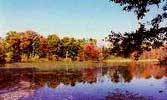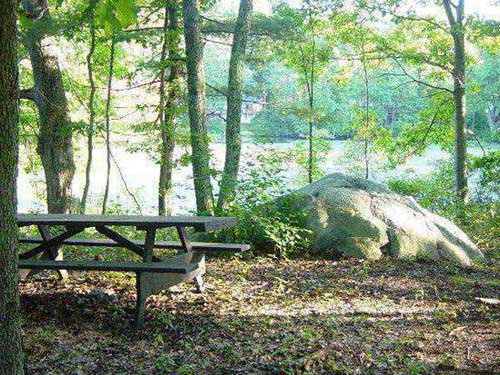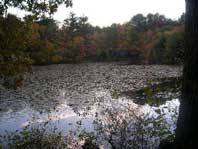


 |
 |
 |
 |
 |
 |
 |
 |
 |
 |
Park Planning
Despite the degradation of the Wilson Mill Park area in the recent past, it supports a wide variety of wildlife, and native plant species. By removing non-native plants in the pond and park area, the Wilson Mill Park Committee, working closely with the Conservation Commission, hopes to foster the natural environment and allow it to recover. This plan will minimize maintenance costs for the town, as well as giving protection to wildlife as the open space available to it in Bedford diminishes.

The Pond
The Committee has proposed the use of town CPA funds for a long term project to clear the pond of invasive water chestnut which threatens the birds, fish, otters and beaver that depend on the pond by depleting the oxygen levels in the water. In the summer the surface growth interferes with boating, and, left unchecked, its decaying biomass also causes the pond to fill faster than the flow of the water currents can clear it.
To improve access to the pond and shore line, the Committee plans to improve and extend footpaths along the shore, and to create a canoe and kayak launch site for the pond. These trails will be available to snow shoers and skaters in the winter time as well. In order to maintain the natural environment for wildlife in and around the pond, however, these trails will be kept to a minimum.
The Mill Site
The present bridge from Old Burlington Road across the old mill race and spillway, which provides the main access to the Park, is functional, but unattractive. The chain link fence was installed by the Public Works Department as a necessary safely barrier. The town is currently preparing to build a weir above the entrance to the race to control water levels in the Vine Brook and Shawsheen River system. Once this work is done, the Committee will be able to improve the aesthetics of the Park entrance, remove destructive vegetation from around the structural remnants in the area and the poison ivy now growing along the mill race ravine. Limited access to the area will be allowed to see the falls and the structures, but the area will also eventually be planted with small native ground cover such as partridge berry, bunchberry, ground pine, fern and arbutus. Trailing arbutus, commonly called mayflower, is the state flower of Massachusetts, but is no longer abundant in many areas of the state due to habitat destruction.
The Streetscape, Grove and Meadow Areas
These areas offer the greatest challenge to the Committee since this is the part of the Park which has suffered the most depletion. A heavy infestation of buckthorn along the shore line helps to screen it off, but has crowded out other species which would be more beneficial to wildlife in the area. The committee hopes to thin out the buckthorn and introduce native species such as Shadbush or Serviceberry, Winterberry, Inkberry and other native plants which provide winter food for birds and small mammals. The areas nearest the pond have some native plants already growing there, and these will be protected and expanded.
The meadow area below the Route 3 bank will be mown to keep it an open area, and the pine grove adjacent to it will also be maintained in its present state. The Committee plans to improve the area along the streetscape gradually. It plans to erect a low wall along the top of the rise parallel to Route 62 broken at intervals by plantings to allow access to bike and trail traffic. This barrier will act as a barrier for traffic noise and roadside litter from the street. The Committee plans to do further planting in this area after an interval for working on soil amendment.


The
goal of the Wilson Mill Park Planning
Committee is to protect, foster and advocate for the historic mill site,
surrounding natural habitat and passive recreation opportunities available
at Wilson Mill Park for the people of Bedford to enjoy.